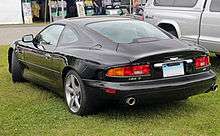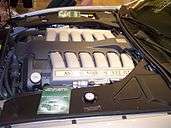Aston Martin DB7
| Aston Martin DB7 | |
|---|---|
_(cropped).jpg) | |
| Overview | |
| Manufacturer | Aston Martin |
| Production |
1994–2004 (7,000 produced) |
| Model years |
1997-1998 (United States & Canada For I6 Model) 2000-2003 (United States & Canada For Vantage Models) |
| Assembly | Bloxham, Oxfordshire, England, United Kingdom |
| Designer | Ian Callum |
| Body and chassis | |
| Class | Grand tourer |
| Body style |
2-door coupé 2-door convertible |
| Layout | FR layout |
| Related | Jaguar XK8 |
| Powertrain | |
| Engine |
3.2 L SC I6 5.9 L V12 |
| Transmission |
5-speed automatic 5/6-speed manual |
| Dimensions | |
| Wheelbase | 2,591 mm (102.0 in) |
| Length |
4,646 mm (182.9 in) (DB7) 4,692 mm (184.7 in) (Vantage) |
| Width | 1,830 mm (72.0 in) |
| Curb weight |
1,825 kg (4,023 lb) (coupe) 1,900 kg (4,200 lb) (Volante) |
| Chronology | |
| Predecessor | Aston Martin Vantage |
| Successor | Aston Martin DB9 |
The Aston Martin DB7 is a grand tourer which was produced by Aston Martin from September 1994 to December 2004. The grand tourer was available either as a coupé or a convertible. The prototype was complete by November 1992, and debuted at the Geneva Motor Show in March, 1993, the car was styled by Ian Callum and Keith Helfet. The six-cylinder DB7 (based on the Jaguar non-supercharged engine AJ6) was positioned as an "entry-level" model below the hand-built V8 Virage introduced a few years earlier. This model was the highest production Aston Martin vehicle ever, with more than 7,000 built before it was replaced by the DB9.
Overview
The DB7, known internally as the NPX project, was made mostly with resources from Jaguar and had the financial backing of the Ford Motor Company, owner of Aston Martin from 1988 to 2007. The DB7's platform is an evolution of the Jaguar XJS's, though with many changes. The styling started life as the still-born Jaguar F type (XJ41 – coupe / XJ42 – convertible) designed by Keith Helfet. Ford cancelled this car and the general design was grafted onto an XJS platform. The styling received modest changes by Ian Callum so that it looked like an Aston Martin. The first generation Jaguar XK-8 also uses an evolution of the XJ-S/DB7 platform and the cars share a family resemblance, though the Aston Martin was significantly more expensive and rare.
The DB7 was engineered in Kidlington, Oxfordshire, by Tom Walkinshaw Racing on behalf of Aston Martin. The engines continued to be built in Kidlington during the production run of the vehicle.
With production of the Virage (soon rechristened "V8" following Vantage styling revisions) continuing at Newport Pagnell, a new factory was acquired at Bloxham, Oxfordshire that had previously been used to produce the Jaguar XJ220, where every DB7 would be built throughout its production run. The DB7 and its relatives were the only Aston Martins produced in Bloxham and the only ones with a steel unit construction inherited from Jaguar (Aston Martin had traditionally used aluminium for the bodies of their cars, and models introduced after the DB7 use aluminium for the chassis as well as for many major body parts).
The convertible Volante version was unveiled at the North American International Auto Show in Detroit in 1996.[1] Both versions have a supercharged straight-six engine that produced 335 bhp (250 kW; 340 PS) and 361 lb·ft (489 N·m) of torque. In the United States, the Coupé sold for $140,000, and the Volante for $150,000. Works Service provided a special Driving Dynamics package, which greatly enhanced performance and handling for drivers who wanted more than what the standard configuration offered.
V12 Vantage
In 1999, the more powerful DB7 V12 Vantage was introduced at the Geneva Motor Show. Its 5.9 litre, 48-valve, V12 engine produced 420 bhp (313 kW; 426 PS) and 400 lb·ft (540 N·m) of torque. It has a compression ratio of 10.3:1. Transmissions were available with either a TREMEC T-56 six speed manual or a ZF 5HP30 five speed automatic gearbox. Aston Martin claimed it had a top speed of either 186 mph (299 km/h) with the manual gearbox or 165 mph (266 km/h) with the automatic gearbox, and would accelerate from 0–60 mph (97 km/h) in 4.9 seconds.[2] It is 4,692 mm long, 1,830 mm (72.0 in) wide, 1,243 mm (48.9 in) high, with a weight of 1,800 kg (3,968.3 lb).
After the launch of the Vantage, sales of the supercharged straight-6 engine DB7 had reduced considerably and so production was ended by mid-1999.
V12 GT and GTA

In 2002, a new variant was launched, named V12 GT or V12 GTA when equipped with an automatic transmission. It was essentially an improved version of the Vantage, its V12 engine producing 435 bhp (324 kW; 441 PS) and 410 lb·ft (560 N·m) of torque for the manual GT, although the automatic GTA retained the 420 bhp (313 kW; 426 PS) and 400 lb·ft (540 N·m) of torque of the standard DB7 Vantage.[3] Additionally, the GT and GTA chassis had substantially updated suspension from the DB7 Vantage models. Aesthetically, compared to the Vantage it has a mesh front grille, vents in the bonnet (hood), a boot (trunk) spoiler, an aluminium gear lever, optional carbon fibre trim and new wheels. It also has 355 mm (14.0 in) front and 330 mm (13.0 in) rear vented disc brakes made by Brembo. When being tested by Jeremy Clarkson on Top Gear in 2003, he demonstrated the car's ability to pull away in fourth gear and continue until it hit the rev limiter: the speedometer indicated 135 mph (217 km/h). Production of the GT and GTA was extremely limited, as only 190 GT's and 112 GTA's were produced worldwide and only 17 were shipped to the US market, for a total of 302 cars.[3]
Special editions
A number of special-edition DB7 cars were built:
- DB7 I6
- 1998 Alfred Dunhill Edition – 150 "platinum metallic" cars with a built-in humidor
- 1998 Neiman-Marcus Edition – 10 special black cars for the 1998 Neiman Marcus Christmas catalogue
- 1999 Stratstone Edition – 19 special black cars, 9 coupes and 10 Volantes
- 1998 Beverly Hills Edition – 6 "Midnight Blue", 2 coupes and 4 Volantes
- DB7 V12 Vantage
- 2003 Jubilee Limited Edition – 24 "jubilee blue" cars were made for Europe and 26 were made for North America to celebrate the Golden Jubilee of Queen Elizabeth II
- 2002 Keswick Limited Edition – A small number of "nero daytona black" models
- 2003 Anniversary Edition – 33 (of an announced 100) "slate blue" cars to celebrate the end of DB7 Vantage production
Special models
Two special edition variants were made late in the DB7's production run:
Images
|
References
- ↑ "Aston DB7 Reference". carautoportal.com. Retrieved 17 June 2009.
- ↑ "Aston Martin DB7 V12 Vantage". astonmartins.com. Retrieved 28 April 2008.
- 1 2 "DB7 VANTAGE". astonmartin.com. Retrieved 31 March 2016.
| Aston Martin Lagonda road car timeline, 1948–present | ||||||||||||||||||||||||||||||||||||||||||||||||||||||||||||||||||||||
|---|---|---|---|---|---|---|---|---|---|---|---|---|---|---|---|---|---|---|---|---|---|---|---|---|---|---|---|---|---|---|---|---|---|---|---|---|---|---|---|---|---|---|---|---|---|---|---|---|---|---|---|---|---|---|---|---|---|---|---|---|---|---|---|---|---|---|---|---|---|---|
| Type | 1940s | 1950s | 1960s | 1970s | 1980s | 1990s | 2000s | 2010s | ||||||||||||||||||||||||||||||||||||||||||||||||||||||||||||||
| 8 | 9 | 0 | 1 | 2 | 3 | 4 | 5 | 6 | 7 | 8 | 9 | 0 | 1 | 2 | 3 | 4 | 5 | 6 | 7 | 8 | 9 | 0 | 1 | 2 | 3 | 4 | 5 | 6 | 7 | 8 | 9 | 0 | 1 | 2 | 3 | 4 | 5 | 6 | 7 | 8 | 9 | 0 | 1 | 2 | 3 | 4 | 5 | 6 | 7 | 8 | 9 | 0 | 1 | 2 | 3 | 4 | 5 | 6 | 7 | 8 | 9 | 0 | 1 | 2 | 3 | 4 | 5 | 6 | 7 | |
| Owner | David Brown | William Wilson | Minden & Sprague | Victor Gauntlett et al. | Ford | Independent Consortium | ||||||||||||||||||||||||||||||||||||||||||||||||||||||||||||||||
| City Car | Cygnet | |||||||||||||||||||||||||||||||||||||||||||||||||||||||||||||||||||||
| Luxury Car | Rapide | |||||||||||||||||||||||||||||||||||||||||||||||||||||||||||||||||||||
| 2.6 ltr | 3 ltr | Rapide | Lagonda | Taraf | ||||||||||||||||||||||||||||||||||||||||||||||||||||||||||||||||||
| Grand Tourer | DB4 | DB5 & Volante | DBS & Vantage | DB7 | Vantage | |||||||||||||||||||||||||||||||||||||||||||||||||||||||||||||||||
| DB1 | DB2 | DB2/4 & MKIII | DB6 | DBS V8 & AM V8 | V8 Virage | V8 | DB9 & V12 Virage | DB11 | ||||||||||||||||||||||||||||||||||||||||||||||||||||||||||||||
| V8 Vantage | V8 Vantage | Vanquish | DBS V12 | Vanquish | ||||||||||||||||||||||||||||||||||||||||||||||||||||||||||||||||||
| Limited Production | One-77 | Vulcan | ||||||||||||||||||||||||||||||||||||||||||||||||||||||||||||||||||||
| DB4 Zagato | V8 Zagato | DB7 Zagato | DB AR1 | V12 Zagato | ||||||||||||||||||||||||||||||||||||||||||||||||||||||||||||||||||
| Concept Car | ||||||||||||||||||||||||||||||||||||||||||||||||||||||||||||||||||||||
| Color code |
Aston Martin badge Lagonda badge | |||||||||||||||||||||||||||||||||||||||||||||||||||||||||||||||||||||
.jpg)
.jpg)
_(cropped).jpg)

